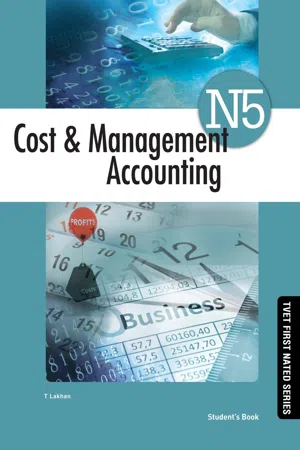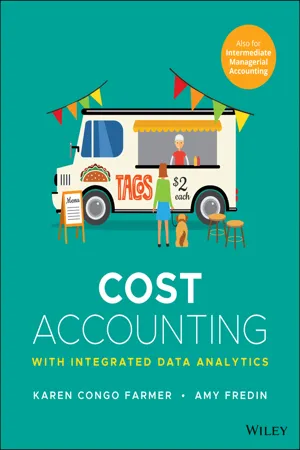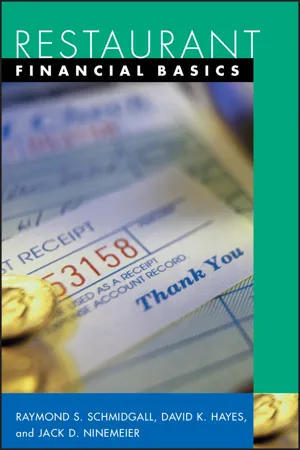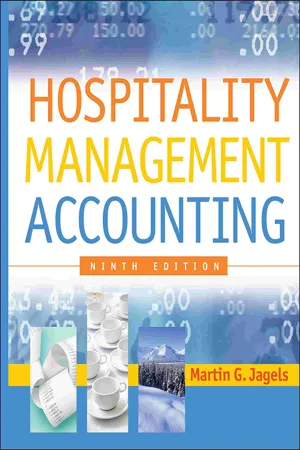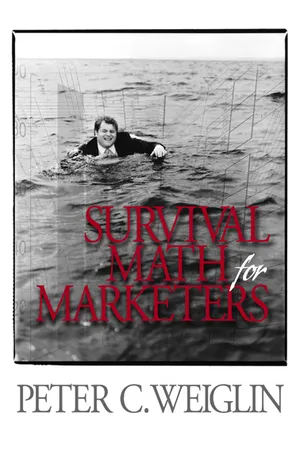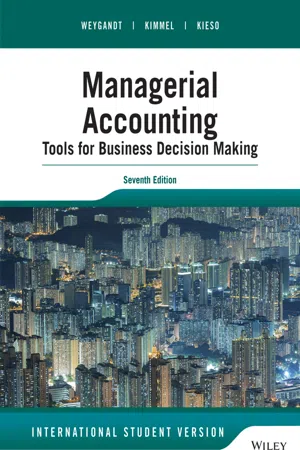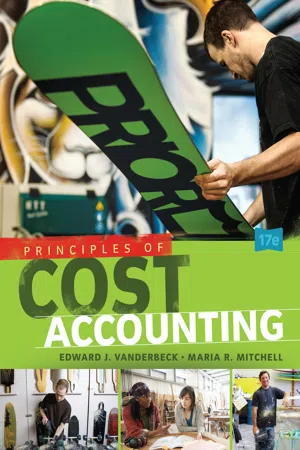Marketing
Fixed cost vs Variable cost
Fixed costs are expenses that remain constant regardless of the level of production or sales, such as rent and salaries. Variable costs, on the other hand, fluctuate with the level of production or sales, such as raw materials and commissions. Understanding the distinction between fixed and variable costs is crucial for marketers to accurately assess the profitability of their campaigns and make informed budgeting decisions.
Written by Perlego with AI-assistance
Related key terms
1 of 5
10 Key excerpts on "Fixed cost vs Variable cost"
- eBook - PDF
- Cecile Laurin, Tage C. Tracy, John A. Tracy, John A. Tracy(Authors)
- 2023(Publication Date)
- For Dummies(Publisher)
Fixed versus variable costs If your business sells 100 more units of a certain item, some of your costs increase accordingly, but others don’t budge one bit. This distinction between variable and fixed costs is crucial: » Variable costs: Variable costs increase and decrease in proportion to changes in sales or production level. Variable costs generally remain the same per unit of product or per unit of activity. Manufacturing or selling additional units causes variable costs to increase in concert. Manufacturing or selling fewer units results in variable costs going down in concert. » Fixed costs: Fixed costs remain the same over a relatively broad range of sales volume or production output. Fixed costs are like a dead weight on the business. Its total fixed costs for the period are a hurdle it must overcome by selling enough units at high enough margins per unit to avoid a loss and move into the profit zone. (Chapter 15 explains the break-even point, which is the level of sales needed to generate enough margin to cover fixed costs for the period.) CHAPTER 16 Accounting for Costs 313 The distinction between variable and fixed costs is at the heart of understanding, analyzing, and forecasting profit, which we explain in Chapter 17. Relevant versus irrelevant costs Not every cost is important to every decision a manager needs to make — hence the distinction between relevant and irrelevant costs: » Relevant costs are costs that should be considered and included in your analysis when deciding on a future course of action. Relevant costs are future costs — costs that you would incur or bring upon yourself depending on which course of action you take. For example, say that you want to increase the number of books that your business produces next year to increase your sales revenue, but the cost of paper has just shot up. - eBook - PDF
Pushing the Numbers in Marketing
A Real-World Guide to Essential Financial Analysis
- David L. Rados(Author)
- 1992(Publication Date)
- Praeger(Publisher)
But in language, usage is all. How to Use Variable Costs 1. Make sure you have an estimate of variable costs of your product, brand, or whatever before you analyze a marketing decision. 2. Watch out for allocations of fixed costs that show up under variable costs. Calling a fixed cost variable doesn't make it variable. FIXED COSTS These costs don't change, in total, over a period of time, over some normal range of operations. These are important qualifications because few costs can be changed in the short run, say one day, and all costs can be changed in the long run, over years. Also, fixed costs may well in- crease if production increases sharply, say, from 60 to 95 percent of capacity. Examples of fixed costs for a manufacturer would include depreciation of plant and equipment, real estate taxes, equipment leases, interest pay- ments, most of the managerial and supervisory payroll, most of the costs of the maintenance crew. Like variable costs, fixed costs do not exist in the absolute. Costs that appear to be given, to be beyond a manager's control, may turn out to be controllable, at least partially, under a different cost control system. If managers are not charged for office space, they will tend to use more of it. If the firm has the opportunity of renting part of its office space to out- siders and charges the foregone rent to the manager, that manager may well find it possible to reduce the space required. What is fixed for one decision may be variable in another. The costs of running a sales branch are fixed for most day-to-day decisions concerning the sales force, but when consideration is given to closing or consolidating the branch these costs are no longer fixed. Such costs, that is, can not prudently be assumed to be fixed. If the decision is important enough, the assumption must be verified. Fixed costs go by other names. They are non-variable costs to some, capacity costs to others. - eBook - PDF
Cost & Management Accounting N5 SB
TVET FIRST
- T Lakhan(Author)
- 2015(Publication Date)
- Macmillan(Publisher)
of units produced Fixed cost Fixed costs are those costs which remain constant no matter how many units are produced. For example, if the rent expense is R10 000 per month, it does not matter if the business produces 1 unit or 1 000 units, it must still pay its landlord R10 000 rent for the month. Variable cost Variable costs are those costs that vary or change in direct proportion to the number of units produced. Example 1.8 Wood (direct material) valued at R10 is needed to make 1 desk. Required: Calculate the direct material cost if 50 desks are produced. Suggested solution Direct material cost for 50 desks = R10 × 50 desks = R500 Notice how the cost varied or changed when the number of units changed. When 1 unit was produced, the variable cost was R10. When the number of units increased to 50, the variable cost increased 50 times. 21 Unit cost and total cost It is important to understand how fixed and variable costs behave both in total and per unit. Think about total cost. When you find the total of something, does it become more or less? Now, do you think you would need to multiply or divide to calculate the total cost? Obviously you must multiply. What about unit cost? Unit means ONE, so you are calculating the cost of producing one unit. Is one the bigger or smaller number? So, when you are performing a calculation, would you multiply or divide to make the answer smaller? Obviously you must divide. Total cost Example 1.9 The following information relates to Summer Ltd: Required: Calculate the total cost. Suggested solution Total cost = Total fixed cost + total variable cost = R100 000 + R50 000 = R150 000 Total, and unit, fixed and variable costs The table below summarises how fixed and variable costs behave, both per unit and in total. - eBook - ePub
- John A. Tracy, Cecile Laurin(Authors)
- 2019(Publication Date)
- For Dummies(Publisher)
However, a decision alternative being considered might involve a change in fixed costs, such as moving out of the present building used by the business, downsizing the number of employees on fixed salaries, spending less on advertising (generally a fixed cost), and so on. Any cost, fixed or variable, that would be different for a particular course of action being analyzed is relevant for that alternative. Furthermore, keep in mind that fixed costs can provide a useful gauge of a business’s capacity — how much building space it has, how many machine-hours are available for use, how many hours of labour can be worked, and so on. Managers have to figure out the best way to utilize these capacities. For example, suppose your retail business pays an annual building rent of $200,000, which is a fixed cost (unless the rental contract with the landlord also has a rent escalation clause based on your sales revenue). The rent, which gives the business the legal right to occupy the building, provides 15,000 square feet of retail and storage space. You should figure out which sales mix of products will generate the highest total margin — equal to total sales revenue less total variable costs of making the sales, including the costs of the goods sold and all variable costs driven by sales revenue and sales volume. Actual, budgeted, and standard costs The actual costs a business incurs may differ (though we hope not too unfavourably) from its budgeted and standard costs: Actual costs: Actual costs are based on actual transactions and operations during the period just ended, or going back to earlier periods. Financial statement accounting is mainly (though not entirely) based on a business’s actual transactions and operations; the basic approach to determining annual profit is to record the financial effects of actual transactions and allocate the historical costs to the periods benefited by the costs - eBook - PDF
Cost Accounting
With Integrated Data Analytics
- Karen Congo Farmer, Amy Fredin(Authors)
- 2022(Publication Date)
- Wiley(Publisher)
Data analytics activities are available at the end of the chapter. Managing Variable Costs The way that variable costs work is intuitive and predictable. And because they’re fairly easy to monitor and manage, variable costs are usually cut first when managers have to reduce costs. Here are some common ways to manage variable costs: • Negotiate bulk purchases for discounts. • Take advantage of cash payment discounts and/or prompt payment discounts from suppliers. • Change suppliers or alternate amongst suppliers. • Modify the quality or quantity of inputs used in production. • Change output/product size (but maintain price). • Minimize overtime hours where such hours are discretionary. Fixed Costs In contrast with variable costs, to really understand fixed costs, we need to discuss capacity first. What’s the capacity of a two-seater sports car, like GM’s Corvette? Two people. In simple terms, capacity is an upper limit on space. When we speak of the Corvette, capacity is how many people will fit. Must you always have two people in it? No. Zero, one, or two are all pos- sibilities. Does changing the number of people in the car from zero to one to two change how much the car originally cost? No. The car’s cost is fixed. That fixed cost enabled the capacity of up to two people. • In a manufacturing context, capacity is how many units could possibly be made, given the space in a particular factory, with its existing equipment. • Fixed costs are fixed in total and do not change as more units are made within the avail- able capacity. • However, this is mind-bending: While they are fixed in total, fixed costs per unit do vary, based on how many units are made. Illustration 2.12 shows that while the cost of the entire pizza is fixed in total, the cost per slice varies with the activity level, that is, the number of units or slices. As we spread fixed costs over more units, the fixed cost per unit decreases—a fundamental management insight. - eBook - PDF
- Raymond S. Schmidgall, David K. Hayes, Jack D. Ninemeier(Authors)
- 2003(Publication Date)
- Wiley(Publisher)
By this definition, “cost” is the same as “expense.” PROFIT MARGIN An overall measure of management’s ability to generate sales and control expenses; profit mar- gin is calculated by dividing net income by total revenue. Costs and Sales Volume One way to consider costs is to think about how they change when there are changes in the activity (sales) of the restaurant. Costs can be seen as fixed, vari- able, or mixed (partly fixed and partly variable). Fixed Costs. Fixed costs remain constant in the short run even when sales volume varies. For example, food sales may increase by 5% or beverage sales may decline by 10%; in both cases a fixed cost such as interest ex- penses remains constant. Figure 7.1 shows a graph that tracks costs and revenue volume. It shows that total fixed costs remain the same even when sales volume increases. Common examples of fixed costs include salaries, rent and insurance ex- pense, property taxes, depreciation expense, and interest expense. Fixed costs are sometimes classified as either capacity or discretionary. Capacity fixed costs re- late to the ability to provide goods and services. For a restaurant, capacity fixed costs relate to the number of seats in the dining area and include depreciation, property taxes, interest, and certain salaries. There is a quality dimension related to capacity fixed costs. For example, if the restaurant were to eliminate its air conditioning system, it could still serve the same number of guests, but at a lower level of service. 157 U N D E R S TA N D I N G C O S T C O N C E P T S A N D B R E A K - E V E N FIXED COSTS Costs that do not vary in the short term even when sales volume varies; examples include salaries and interest expense. CAPACITY FIXED COSTS Charges relating to the prop- erty or its capacity to pro- vide goods and services. Total Fixed Costs Per Unit Fixed Costs 0 Sales Volume Costs Figure 7.1 Total and Per Unit Fixed Costs - eBook - PDF
- Martin G. Jagels(Author)
- 2006(Publication Date)
- Wiley(Publisher)
However, the motel owner would happily endure this opportunity cost if net income from running the operation were greater than any potential rent income. A standard cost is what a cost should be for a given level of sales revenue or volume of business. The final three types of cost discussed in this chapter were fixed costs, variable costs, and semifixed or semivariable costs. Fixed costs D I S C U S S I O N Q U E S T I O N S 321 are costs that do not change in the short run, regardless of the volume of sales revenue (the general manager’s annual salary is an example). Variable costs are those that do vary in the short run and do so in direct proportion to sales rev- enue (food and liquor costs are two good examples of variable costs). Most costs, however, do not fall neatly into either the fixed or the variable category; they are semifixed or semivariable costs. To make useful decisions concerning fixed and variable costs and their effect on net income at various levels of sales, the semicosts must be divided into their fixed and variable elements. Three meth- ods were used to illustrate how this can be done. 1. The high–low method, although quick and easy to use, may give misleading results if the high and low sales periods selected are not truly representative of the costs in all periods. 2. The multipoint graph eliminates the possible problem built into the high–low method. The graph is subject to some element of personal judgment, but in most cases will give results that are close enough for most decision-making purposes. 3. Regression analysis, which is the most accurate method, involves quite a number of calculations and can probably best be used as a spot check on the results of using one of the other two methods. D I S C U S S I O N Q U E S T I O N S 1. Differentiate between a direct cost and an indirect cost. 2. Define discretionary cost and give two examples (other than those given in the text). - eBook - PDF
- Peter C. Weiglin(Author)
- 2002(Publication Date)
- SAGE Publications, Inc(Publisher)
Seven Costs and Profitability Costs, Real and Imagined It may sound silly that to succeed as a marketer you must understand costs. But, you might think, isn’t that for the Production and Finance people? Multiply the cost per widget by the number of widgets involved and you arrive at a total cost. Marketing people focus on customers and prices, not costs. Marketing people also have to understand costs, and, more important, they have to understand how people think about costs. This is especially important, because not everything that people think about costs is true. For example, we just talked about widgets, cost per widget, and total cost. But the calculation that is done more often is the reverse of what I described above: We start with a number of cost components, add them up to get a total cost, and then divide by the number of widgets produced to get the average cost per widget. If we increase production by 50%, will we still have the same cost per widget? The temptation is to take our aver-age cost and multiply that by the new production quota, at which point we enter unreality. It doesn’t work that way. I have already discussed the retailer who can’t understand why, even with a high markup, there isn’t enough money at the end of the month. A similar problem is faced by manufacturers, providers of services, and, in fact, anybody who runs a business. I’ll take up the subject of breaking even in the next chapter. For now, let’s look at our costs. 65 Variable, Fixed, and Somewhere in Between First of all, a cost is the expenditure of resources to achieve a desired end. Essentially, we have to consider three kinds of costs, depending on how they vary as production levels change. They are variable costs, fixed costs, and semivariable costs. Variable costs are directly affected by the number of units produced. If no units are produced, the cost is zero. For each unit produced, there is a materials component and a labor component. - eBook - PDF
Managerial Accounting
Tools for Business Decision Making
- Jerry J. Weygandt, Paul D. Kimmel, Donald E. Kieso(Authors)
- 2015(Publication Date)
- Wiley(Publisher)
Fixed costs Costs that remain the same in total regard-less of changes in the activity level. High-low method A mathematical method that uses the total costs incurred at the high and low levels of activity to classify mixed costs into fixed and variable components. Margin of safety The difference between actual or expected sales and sales at the break-even point. Mixed costs Costs that contain both a variable- and a fixed-cost element and change in total but not propor-tionately with changes in the activity level. Relevant range The range of the activity index over which the company expects to operate during the year. Target net income The income objective set by man-agement. Unit contribution margin The amount of revenue remain-ing per unit after deducting variable costs; calculated as unit selling price minus unit variable costs. Variable costs Costs that vary in total directly and pro-portionately with changes in the activity level. GLOSSARY REVIEW DECISION TOOLS REVIEW DECISION CHECKPOINTS INFO NEEDED FOR DECISION TOOL TO USE FOR DECISION HOW TO EVALUATE RESULTS What was the contribution toward fixed costs and income from each unit sold? What would be the increase in income as a result of an increase in sales? At what amount of sales does a company cover its costs? Unit Unit Unit contribution 5 selling 2 variable margin price cost Contribution Unit Unit margin 5 contribution 4 selling ratio margin price Break-even point analysis In units: Break-even Fixed costs point 5 Unit contribution margin In dollars: Break-even Fixed costs point 5 Contribution margin ratio Every unit sold will increase income by the contribution margin. Every dollar of sales will increase income by the contribution margin ratio. Below the break-even point, the company is unprofitable. Selling price per unit and variable cost per unit Unit contribution margin and unit selling price Unit selling price, unit variable cost, and total fixed costs 1. - eBook - PDF
- Edward Vanderbeck, Maria Mitchell(Authors)
- 2015(Publication Date)
- Cengage Learning EMEA(Publisher)
Cengage Learning reserves the right to remove additional content at any time if subsequent rights restrictions require it. of increasing the percentage of variable costs to sales and lowering fixed costs. Management believes that fixed costs can be reduced to $5,000, with a corre-sponding increase in the percentage of variable costs to sales to 80%. (For example, the base salaries of salespersons could be lowered, and their com-mission percentage could be raised.) The break-even sales volume calculated with these conditions is as follows: Break-even sales volume ¼ $5,000 1 0 : 80 ¼ $5,000 0 : 20 ¼ $25,000 If the proposed shift from fixed costs to variable costs is accomplished, then the break-even point would be reduced from $50,000 to $25,000. The higher the variable costs, the smaller the risk of not attaining the expected break-even point because the variable costs are incurred only if orders for the product are received. However, if the sales volume exceeds expectations, a larger portion of the sales revenue beyond break-even will be used to cover the variable costs, resulting in a smaller net operating income than if costs were mostly fixed. The relationship of the changes in net operating income to changes in sales volumes based on the proportion of variable and fixed costs is referred to as operating leverage . To illustrate, assume that Bradford Industries achieves a sales volume of $200,000. With a variable cost percentage of 70% and $15,000 of fixed costs, the net income would amount to $45,000. If the fixed costs were reduced to $5,000 and the variable cost percentage increased to 80%, the profit would be only $35,000 — a reduction of $10,000 at the same sales volume: Variable Cost Rate 70% 80% Sales . . . . . . . . . . . . . . . . . . . . . . . . . . . . . . . . . . . . . . . . . . . . . . . . . . . . . $200,000 $200,000 Variable costs . . . . . . . . . . . . . . . . . . . . . . . . . . . .
Index pages curate the most relevant extracts from our library of academic textbooks. They’ve been created using an in-house natural language model (NLM), each adding context and meaning to key research topics.


